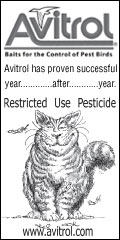
| December 2015 | Past Issues | Printer-Friendly | Advertise | Affiliates Search | Find a Pest Control Operator | PCOC.org |
|
EVP NOTES
This is the season for giving thanks. I know we have just had Thanksgiving, which is my favorite holiday probably because it was the first holiday that I spent in the U.S. .....42 year ago! Giving thanks is a uniquely human activity not observed in the rest of the animal kingdom. It is also one of the healthiest emotions that we can feel. So, in the spirit of the season....... As I think about all the many things I have to be thankful for, I also reflect on the state of business and the many entrepreneurs who have made this country so great. Compared to Europe, which has not created any net new jobs in the last ten years, we who live and work in the United States of America have reason to give thanks for a government climate which (generally and comparatively speaking!) encourages individuals to create risks in starting a growing a business and provides good jobs. Also, the ability to object to new laws and regulations in an open and honest environment. As an industry, one of the things that has always amazed me is the enthusiasm and camaraderie that is so powerful. At each of PCOC’s 19 district meetings, I see evidence that a caring and helpful attitude exists between individuals who may compete with one another during the day. For this, I am truly thankful, because it energizes me every time I experience it! This atmosphere is a significant indicator of what a powerful force the pest control industry is in California. It attests to the potential impact that your trade association can have on state government in protecting the pest control industry in California. My suggestion is that we all take a few minutes of quiet time to mentally list all the things we have to be thankful for. I think you will be surprised, even during these hard economic times, that the list is quite long. Happy Holidays! LEGISLATIVE UPDATE
IN THE NEWS
George Farnsworth and Donna Marciano, two long-time Department of Pesticide Regulation employees, have taken on new roles. Over the summer George Farnsworth, DPR’s former Enforcement Branch Manager, promoted to Associate Director of the Pesticide Programs Division. He now oversees four branches of DPR: Licensing, Product Compliance, Environmental Monitoring, and Enforcement. He also oversees the DPR’s outreach to agricultural commissioners. Farnsworth was promoted into the position in July, replacing Charles M. Andrews. Previously, he was Chief of the Pesticide Enforcement Branch. He began his career with DPR in the 1990’s and has built up a wealth of experience. Although he first started as a registration specialist with the Registration Branch, he took a special assignment under the Assistant Director where he worked on projects including harmonization with U.S. EPA. He moved to the Pesticide Enforcement Branch and later became the first Chief of the Product Compliance Branch when those activities were split off from the Enforcement Branch. Farnsworth also worked in DPR’s Worker Health and Safety Branch where he managed the Pesticide Illness and Surveillance and Exposure Monitoring and Industrial Hygiene programs. During his career, Farnsworth has overseen a number of initiatives, including the under-collection of mill assessment primarily from big-box stores, establishing pesticide container recycling requirements, and development of the California Pesticide Enforcement Activity Tracking System CalPEATS. Farnsworth is a graduate of California Polytechnic State University, San Luis Obispo. He holds a degree in Crop Sciences. Prior to joining the state, he worked as a foreman for a rice grower in Grimes, California. He later worked for a pesticide application company, obtained his Pest Control Advisor license and headed a division overseeing large-scale, commercial applications. After five years, he struck out on his own and later sold his business to his former employer. In 1992, he joined the Yolo County Agricultural Commissioner’s office as an agricultural biologist, inspecting pesticide applications to ensure they conformed to the law and providing training in pesticide use. He joined DPR a year later.
She was formerly manager of the Product Compliance Branch. Marciano joined DPR in 2000 as a pesticide-use specialist in the Enforcement Branch. She has played a critical role in a number of high-profile investigations. In 2004, she helped investigate an outbreak of infections at Bay Area nail salons linked to unsanitary foot spas - some cleaned with an unregistered and ineffective "sanitizer." Dozens of people suffered bacterial infections. In 2003, her diligent efforts paid off as she helped to lead an investigation into unregistered, imported packages of "Advantage" and "Frontline" pet flea products. The sellers avoided registering the products in the U.S. and California to boost their profit margins. In many instances, the products were repackaged with false labels, and some lacked adequate instructions. As a result, some people could have misapplied the products and injured their pets. As a result of the DPR investigations, more than a dozen distributors of unregistered pet flea treatments have paid more than a million dollars in penalties. Maricano and her Product Compliance Branch staff have also conducted investigations that have led to legal action against companies selling unregistered "anti-bacterial" cat litter, "anti-microbial" rubber cleaning gloves, and "anti-fungal" shower curtains. "We look at the claims they are making and challenge the companies’ claims," Marciano said. "They are misleading the consumer." A graduate of Cal Poly, San Luis Obispo, Marciano holds a bachelor’s degree in natural resource management. Prior to joining DPR, she worked with the Sacramento Tree Foundation. Marciano’s family currently grows cherry and walnuts in Northern California. UPCOMING EVENTS
2016
Pestech 3.0 — January 5-7, 2016
San Jose Marriot- San Jose, California NPMA Event Registration PestEd South- January 19, 2016 Quiet Cannon- Montebello, California PestEd North- January 21, 2016 Red Lion Woodlake Hotel- Sacramento, California PestEd 2016 Registration PCOC Legislative Day- April 4-6, 2016
Comings and Goings
Welcome to a new section of Newsbriefs! Here, we will give news from our members: new hires, retirements, etc. If you have some news you would like to share, please send a short sentence or two to breann@pcoc.org. MEMBER NEWS
MEMBER VALUE PROGRAM
PCOC MONTHLY INSURANCE/SAFETY TIP
Two Techniques to Trim Claim Costs
California mandates two cost-saving claims review techniques: utilization review (UR) and independent medical review (IMR). Here’s a brief overview of how they work.
Utilization reviews have saved companies around the country billions of dollars in workers’ compensation costs since California mandated utilization review in 2004. The California legislation, since adopted by many other states, requires every employer (or its workers' compensation claims administrator) to establish a utilization review (UR) process. Utilization review is a process reviewing and approving medical treatment based on medical necessity to cure and relieve work-related illness and injury. UR can bring greater cost-efficiency to the recovery process and help injured workers return to health more quickly. It ensures that treatments are administered within established scientific guidelines — usually those compiled by The American College of Occupational and Environmental Medicine (ACOEM). Studies have shown that UR effectively tames workers’ compensation costs. A report prepared by the California Workers Compensation Institute on the impact of reform legislation shows that in five of six types of services, utilization review resulted in fewer visits and lower amounts paid per claim. Not all URs are created equal. Differences in approach by the client and the medical management company can cause a huge disparity in results. For instance, all utilization review providers use registered nurses to perform the original review. If they find discrepancies, they often refer the case to a consulting physician, who charges much higher rates. Instead, it’s often cheaper and more effective for the nurse to contact the provider to discuss the reasons for the apparently inappropriate treatment. Utilization review for workers’ compensation claims must take a different approach than UR for non-occupational claims. Since workers’ compensation also pays for lost time claims, a more costly treatment that reduces an injured worker’s time away from the job could be the most cost-effective solution. Using occupational healthcare providers to manage the treatment of injured workers can help. Occupational healthcare specialists have experience in treating workers’ compensation patients and expert knowledge of the physical demands of work. When using an occupational medicine specialist to coordinate treatment, employees are more likely to get the treatment they need to get back to work sooner with fewer rebounds. Independent Medical Review
Where utilization review ends, independent medical review (IMR) begins. If utilization review denies or delays a treating physician’s request for services, California law gives an injured worker the right to request independent medical review. In this process, the worker will contact the Division of Workers’ Compensation (DWC), which will contract with an independent medical review organization to conduct IMR. Employers pay the cost of IMR, which varies depending on the nature of the treatment and the number of medical professionals required to resolve the dispute. Still, the DWC says is "significantly lower" than the cost of litigating. For more information or assistance with safety and compliance issues, please contact the PCOC Insurance Program Department at EPIC, (877) 860-7378 or visit www.pcocinsurance.com. NEW MEMBERS
FREQUENTLY REQUESTED INFORMATION
NPMA LOGIN FOR JOINT MEMBERSHIP LOGIN: 313501 PASSWORD: PCOC Department of Fish & Game Department of Food & Agriculture Department of Pesticide Regulation (DPR)
www.cdpr.ca.gov DPR on Facebook www.facebook.com/capesticideregulation DPR on YouTube (see "playlists" for videos pertaining to new surface water regulations) www.youtube.com/user/californiapesticides DPR on Twitter twitter.com/ca_pesticides DPR LinkedIn www.linkedin.com/company/california-department-of-pesticide-regulation Healthy Schools Act http://apps.cdpr.ca.gov/schoolipm/ Structural Pest Control Board www.pestboard.ca.gov Find Your Legislator |
Pest Control Operators of California |
 |






